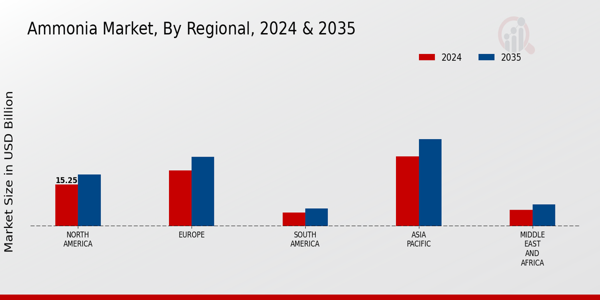Global Trade Dynamics
The Global Ammonia Market Industry is significantly impacted by global trade dynamics, including tariffs, trade agreements, and geopolitical factors. Countries that are major producers of ammonia, such as Russia and the United States, play a crucial role in the global supply chain. Changes in trade policies can influence ammonia prices and availability, affecting industries reliant on this essential compound. As nations navigate complex trade relationships, the ammonia market may experience fluctuations that could either hinder or facilitate growth. Understanding these dynamics is essential for stakeholders in the ammonia industry to strategize effectively.
Industrial Applications
The Global Ammonia Market Industry is significantly influenced by its diverse industrial applications, particularly in the production of chemicals and plastics. Ammonia is utilized in the synthesis of various compounds, including ammonium sulfate and nitric acid, which are vital for numerous industrial processes. The increasing industrialization in emerging economies contributes to the growing consumption of ammonia. As industries expand, the demand for ammonia is likely to rise, further solidifying its position in the global market. This trend indicates a robust future for the ammonia market, as it adapts to the evolving needs of various sectors.
Technological Advancements
Technological advancements play a pivotal role in shaping the Global Ammonia Market Industry. Innovations in ammonia synthesis processes, such as the Haber-Bosch process, are being optimized to enhance efficiency and reduce energy consumption. Furthermore, the development of alternative production methods, including electrochemical synthesis, holds promise for the future of ammonia production. These advancements not only improve the economic viability of ammonia production but also contribute to sustainability efforts. As technology continues to evolve, it is likely to drive growth in the ammonia market, enabling it to meet the demands of various industries more effectively.
Market Trends and Projections
The Global Ammonia Market Industry is projected to experience steady growth, with a market value expected to reach 91 USD Billion by 2035. This growth is underpinned by a compound annual growth rate of 2.1% from 2025 to 2035. Key trends influencing this trajectory include increasing agricultural demands, industrial applications, and technological innovations. As the market evolves, stakeholders must remain vigilant to emerging trends and adapt their strategies accordingly. The interplay of these factors will shape the future landscape of the ammonia market, presenting both challenges and opportunities for industry participants.
Rising Demand for Fertilizers
The Global Ammonia Market Industry experiences a notable surge in demand for fertilizers, primarily driven by the need to enhance agricultural productivity. Ammonia serves as a key ingredient in nitrogen-based fertilizers, which are essential for crop growth. As global populations increase, the demand for food escalates, leading to a projected market value of 72.4 USD Billion in 2024. This growth trajectory is expected to continue, with the market anticipated to reach 91 USD Billion by 2035, reflecting a compound annual growth rate of 2.1% from 2025 to 2035. The agricultural sector's reliance on ammonia-based fertilizers underscores its critical role in food security.
Environmental Regulations and Sustainability
The Global Ammonia Market Industry faces increasing pressure from environmental regulations aimed at reducing greenhouse gas emissions. Ammonia, while essential for various applications, can contribute to environmental concerns if not managed properly. As a result, there is a growing emphasis on sustainable ammonia production methods, such as green ammonia, which utilizes renewable energy sources. This shift towards sustainability not only aligns with global environmental goals but also opens new avenues for innovation within the ammonia sector. The industry's ability to adapt to these regulations may influence its growth trajectory in the coming years.























Leave a Comment